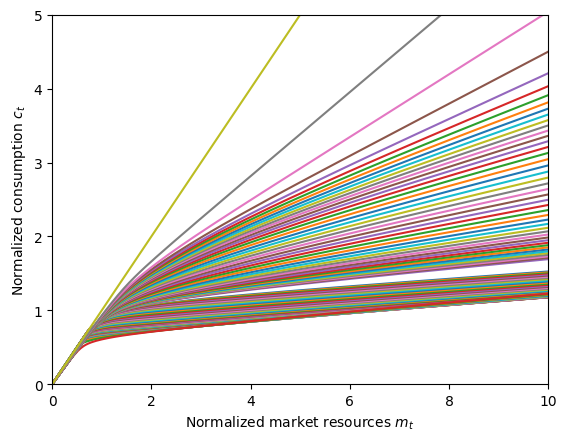Interactive online version:
Advanced and Uncommon HARK Concepts#
The “Gentle Introduction to HARK” and other notebooks mostly focused on the most important features that a new user would want to be familiar with. But HARK has a lot more options and deeper structure, and this notebook describes some of those “advanced” topics.
Measuring Up: Distance in HARK#
In heterogeneous agents macroeconomics, we are often interested in infinite horizon models. Such models are usually solved by “finite horizon approximation”: iteratively solving backward one period at a time until consecutive solutions are sufficiently close together that we conclude the process has converged. When using Bellman value functions, this logic relies on the fact that the Bellman operator is a contraction mapping.
But what does it mean to be “sufficiently close”? What are we even comparing when we talk about the “distance” between two candidate solutions? It depends on the context, and so HARK has a system for easily identifying “what matters” when calculating the distance between two abstract objects.
Particularly, all classes in HARK that could reasonably be part of the representation of a model solution inherit from the superclass HARK.metric.MetricObject. Essentially all this class does is provide a “universal distance metric” with simple customization.
The only think that a subclass of MetricObject needs to specify is a class attribute called distance_criteria, which must be a list of strings. Each element of distance_criteria names an attribute of that class that should be compared if HARK is ever asked to compare two instances of that class.
HARK’s universal distance metric is nothing more than a “recursive supremum norm”. That is, it returns the highest value among element-wise distances. Its logic to compare \(A\) and \(B\) is straightforward and obvious:
if \(A\) and \(B\) are both numbers, their distance is the absolute value of their difference
if \(A\) and \(B\) are both lists, then:
if the lists have the same length, their distance is the maximum distance between corresponding elements
otherwise, the distance is the difference in their lengths
if \(A\) and \(B\) are both
numpy.array, then:if the arrays have the same shape, then the distance is the absolute value of the maximum difference between corresponding elements
if the arrays have different numbers of dimensions, return 10000 times the difference in cardinality
else return the sum of absolute differences in size in each dimension
if \(A\) and \(B\) are both dictionaries, then:
if they both have
distance_criteriaentries that match, their distance is the maximum distance among keys named in distance criteriaelse if they have the same keys, their distance is the maximum distance among their entries
otherwise, their distance is 1000, a large number
if \(A\) and \(B\) are objects of the same class, and neither is a lambda function, then their distance is given by their
distancemethodotherwise, the distance is 1000 because the objects cannot be meaningfully compared
As long as you are coding with MetricObject subclasses (like the interpolators in HARK.interpolation) and standard numeric Python objects, the distance metric will always succeed in comparing objects.
Note that comparing “incomparable” objects, like arrays of different shapes, will return a somewhat arbitrary “large” number (not near zero). This is because the sole purpose of measuring “distance” in HARK is to evaluate whether two solutions are sufficiently close. The tolerance level for such operations is usually on the order of \(10^{-4}\) to \(10^{-8}\), not \(10\) or \(1000\). That is, those “error code distances” mostly serve to ensure that a convergence criteria will definitely not be met when the comparitors are incomparable.
The tolerance for convergence is stored in the tolerance attribute of AgentType instances. It has a default of \(10^{-6}\) but can be freely changed.
HARK only compares solutions from consecutive iterations when solving an infinite horizon model. In the future, we might add extended options to (say) compare a new solution to the one \(N\) periods prior.
Uncommon Options When Solving Models#
The solve() method is usually called without any arguments, but there are a few options you can specify.
Tell Me More, Tell Me More: verbose#
First, passing verbose=True (or just True, because it is the first argument) when solving an infinite horizon model (cycles=0) will print solution progress to screen. This can be useful when developing a new model, if you want to know how long iterations take and how the solver is doing with respect to convergence.
[1]:
from HARK.ConsumptionSaving.ConsIndShockModel import IndShockConsumerType
[2]:
VerboseType = IndShockConsumerType(cycles=0)
VerboseType.solve(True)
Finished cycle #1 in 0.0010006427764892578 seconds, solution distance = 100.0
Finished cycle #2 in 0.002000570297241211 seconds, solution distance = 10.088015890333434
Finished cycle #3 in 0.0010135173797607422 seconds, solution distance = 3.3534114736589693
Finished cycle #4 in 0.0010001659393310547 seconds, solution distance = 1.6699529613894306
Finished cycle #5 in 0.0010006427764892578 seconds, solution distance = 0.9967360674688486
Finished cycle #6 in 0.0009891986846923828 seconds, solution distance = 0.6602619046109499
Finished cycle #7 in 0.0010104179382324219 seconds, solution distance = 0.4680948423143789
Finished cycle #8 in 0.0 seconds, solution distance = 0.34807706501006663
Finished cycle #9 in 0.0010006427764892578 seconds, solution distance = 0.2681341538834978
Finished cycle #10 in 0.0010006427764892578 seconds, solution distance = 0.21223248168627507
Finished cycle #11 in 0.0010001659393310547 seconds, solution distance = 0.17162798586899441
Finished cycle #12 in 0.0010001659393310547 seconds, solution distance = 0.14121714401876462
Finished cycle #13 in 0.0009999275207519531 seconds, solution distance = 0.11786112023934692
Finished cycle #14 in 0.0009996891021728516 seconds, solution distance = 0.09954374358267515
Finished cycle #15 in 0.0010008811950683594 seconds, solution distance = 0.08492077965589839
Finished cycle #16 in 0.0010001659393310547 seconds, solution distance = 0.07306820983636841
Finished cycle #17 in 0.0009999275207519531 seconds, solution distance = 0.06333371450893921
Finished cycle #18 in 0.0010004043579101562 seconds, solution distance = 0.055246317280595036
Finished cycle #19 in 0.0010001659393310547 seconds, solution distance = 0.04845886926538645
Finished cycle #20 in 0.0 seconds, solution distance = 0.04271110960013802
Finished cycle #21 in 0.0010008811950683594 seconds, solution distance = 0.03780486582230225
Finished cycle #22 in 0.0009996891021728516 seconds, solution distance = 0.03358704056809492
Finished cycle #23 in 0.0009875297546386719 seconds, solution distance = 0.02993783577570497
Finished cycle #24 in 0.0009987354278564453 seconds, solution distance = 0.026762425833982917
Finished cycle #25 in 0.0010154247283935547 seconds, solution distance = 0.02398495974448922
Finished cycle #26 in 0.0010001659393310547 seconds, solution distance = 0.02154418103929423
Finished cycle #27 in 0.0010004043579101562 seconds, solution distance = 0.019390181762538816
Finished cycle #28 in 0.0010001659393310547 seconds, solution distance = 0.017481967390489572
Finished cycle #29 in 0.0010001659393310547 seconds, solution distance = 0.015785611379662612
Finished cycle #30 in 0.0010001659393310547 seconds, solution distance = 0.014272839895086431
Finished cycle #31 in 0.0010008811950683594 seconds, solution distance = 0.012919936192925974
Finished cycle #32 in 0.000985860824584961 seconds, solution distance = 0.011706884785618321
Finished cycle #33 in 0.0010142326354980469 seconds, solution distance = 0.010616703056520294
Finished cycle #34 in 0.0009999275207519531 seconds, solution distance = 0.009634898474986997
Finished cycle #35 in 0.0 seconds, solution distance = 0.008749044420678587
Finished cycle #36 in 0.0010001659393310547 seconds, solution distance = 0.007948413988064118
Finished cycle #37 in 0.0010008811950683594 seconds, solution distance = 0.007223724470822646
Finished cycle #38 in 0.0009996891021728516 seconds, solution distance = 0.006566906564932307
Finished cycle #39 in 0.0010001659393310547 seconds, solution distance = 0.005970916077072452
Finished cycle #40 in 0.00099945068359375 seconds, solution distance = 0.005429579002498741
Finished cycle #41 in 0.0010004043579101562 seconds, solution distance = 0.004937463273915199
Finished cycle #42 in 0.000986337661743164 seconds, solution distance = 0.004489772052600927
Finished cycle #43 in 0.0010139942169189453 seconds, solution distance = 0.00408225454644251
Finished cycle #44 in 0.0010008811950683594 seconds, solution distance = 0.0037111311701636396
Finished cycle #45 in 0.0009996891021728516 seconds, solution distance = 0.003373030500464669
Finished cycle #46 in 0.0009999275207519531 seconds, solution distance = 0.0030649359736796278
Finished cycle #47 in 0.0010006427764892578 seconds, solution distance = 0.0027841406665807256
Finished cycle #48 in 0.0 seconds, solution distance = 0.0025282088157077
Finished cycle #49 in 0.0009999275207519531 seconds, solution distance = 0.0022949429754119954
Finished cycle #50 in 0.0010004043579101562 seconds, solution distance = 0.0020823559119378388
Finished cycle #51 in 0.0010004043579101562 seconds, solution distance = 0.0018886464739757969
Finished cycle #52 in 0.0009996891021728516 seconds, solution distance = 0.0017121788176552855
Finished cycle #53 in 0.0010008811950683594 seconds, solution distance = 0.0015514644867233862
Finished cycle #54 in 0.0009996891021728516 seconds, solution distance = 0.0014051468883913287
Finished cycle #55 in 0.001001119613647461 seconds, solution distance = 0.0012719878080478253
Finished cycle #56 in 0.0009992122650146484 seconds, solution distance = 0.0011508556554602478
Finished cycle #57 in 0.0010004043579101562 seconds, solution distance = 0.0010407151830378325
Finished cycle #58 in 0.0010004043579101562 seconds, solution distance = 0.0009406184572169352
Finished cycle #59 in 0.0009999275207519531 seconds, solution distance = 0.0008496968979514463
Finished cycle #60 in 0.0009877681732177734 seconds, solution distance = 0.000767154229857514
Finished cycle #61 in 0.0 seconds, solution distance = 0.0006922602130678968
Finished cycle #62 in 0.0010128021240234375 seconds, solution distance = 0.000624345042195884
Finished cycle #63 in 0.0009868144989013672 seconds, solution distance = 0.0005627943195669616
Finished cycle #64 in 0.001001596450805664 seconds, solution distance = 0.0005070445234864884
Finished cycle #65 in 0.0010123252868652344 seconds, solution distance = 0.0004565789051689251
Finished cycle #66 in 0.0010006427764892578 seconds, solution distance = 0.0004109237583840297
Finished cycle #67 in 0.0009999275207519531 seconds, solution distance = 0.00036964501506320246
Finished cycle #68 in 0.0010001659393310547 seconds, solution distance = 0.00033234512761959323
Finished cycle #69 in 0.0010001659393310547 seconds, solution distance = 0.0002986602050079057
Finished cycle #70 in 0.0010001659393310547 seconds, solution distance = 0.0002682573749837047
Finished cycle #71 in 0.0010001659393310547 seconds, solution distance = 0.00024083234929284103
Finished cycle #72 in 0.0010001659393310547 seconds, solution distance = 0.00021610717220754694
Finished cycle #73 in 0.0009999275207519531 seconds, solution distance = 0.0001938281357389826
Finished cycle #74 in 0.0 seconds, solution distance = 0.0001737638473713332
Finished cycle #75 in 0.001001119613647461 seconds, solution distance = 0.00015570343805260123
Finished cycle #76 in 0.0009999275207519531 seconds, solution distance = 0.00013945489982702952
Finished cycle #77 in 0.0010001659393310547 seconds, solution distance = 0.00012484354371933293
Finished cycle #78 in 0.0009860992431640625 seconds, solution distance = 0.00011171056964087711
Finished cycle #79 in 0.0010137557983398438 seconds, solution distance = 9.991174074386322e-05
Finished cycle #80 in 0.0010004043579101562 seconds, solution distance = 8.931615549556682e-05
Finished cycle #81 in 0.0010001659393310547 seconds, solution distance = 7.980511119587419e-05
Finished cycle #82 in 0.0010001659393310547 seconds, solution distance = 7.12710531196592e-05
Finished cycle #83 in 0.0010001659393310547 seconds, solution distance = 6.361660386744461e-05
Finished cycle #84 in 0.0010006427764892578 seconds, solution distance = 5.675366786039859e-05
Finished cycle #85 in 0.0010004043579101562 seconds, solution distance = 5.060260605649347e-05
Finished cycle #86 in 0.0009996891021728516 seconds, solution distance = 4.5091476412739695e-05
Finished cycle #87 in 0.0 seconds, solution distance = 4.0155335675251536e-05
Finished cycle #88 in 0.0010008811950683594 seconds, solution distance = 3.573559836667073e-05
Finished cycle #89 in 0.0010004043579101562 seconds, solution distance = 3.1779449082502964e-05
Finished cycle #90 in 0.0010004043579101562 seconds, solution distance = 2.8239304256771902e-05
Finished cycle #91 in 0.0010001659393310547 seconds, solution distance = 2.507231993220671e-05
Finished cycle #92 in 0.0010004043579101562 seconds, solution distance = 2.2239942116364375e-05
Finished cycle #93 in 0.0010004043579101562 seconds, solution distance = 1.970749654489623e-05
Finished cycle #94 in 0.0009999275207519531 seconds, solution distance = 1.7443814823714376e-05
Finished cycle #95 in 0.0010004043579101562 seconds, solution distance = 1.54208941594014e-05
Finished cycle #96 in 0.000986337661743164 seconds, solution distance = 1.3613587938721139e-05
Finished cycle #97 in 0.0010139942169189453 seconds, solution distance = 1.1999324726730265e-05
Finished cycle #98 in 0.0010006427764892578 seconds, solution distance = 1.0557853295622976e-05
Finished cycle #99 in 0.0 seconds, solution distance = 9.271011538913854e-06
Finished cycle #100 in 0.0009996891021728516 seconds, solution distance = 8.122517190400913e-06
Finished cycle #101 in 0.0010004043579101562 seconds, solution distance = 7.097778525810838e-06
Finished cycle #102 in 0.0010004043579101562 seconds, solution distance = 6.183723237906946e-06
Finished cycle #103 in 0.0009999275207519531 seconds, solution distance = 5.368643900993675e-06
Finished cycle #104 in 0.0010001659393310547 seconds, solution distance = 4.642058520687442e-06
Finished cycle #105 in 0.0009996891021728516 seconds, solution distance = 3.99458479938275e-06
Finished cycle #106 in 0.0010001659393310547 seconds, solution distance = 3.4178268535356437e-06
Finished cycle #107 in 0.0010006427764892578 seconds, solution distance = 2.9042732059281207e-06
Finished cycle #108 in 0.0009996891021728516 seconds, solution distance = 2.4472050079715757e-06
Finished cycle #109 in 0.0010008811950683594 seconds, solution distance = 2.0406135377015744e-06
Finished cycle #110 in 0.0009996891021728516 seconds, solution distance = 1.679126009790366e-06
Finished cycle #111 in 0.0010004043579101562 seconds, solution distance = 1.357939007018416e-06
Finished cycle #112 in 0.0 seconds, solution distance = 1.0727586712278026e-06
Finished cycle #113 in 0.0010001659393310547 seconds, solution distance = 8.19747068891985e-07
Notice that the solver terminated as soon as the distance went below \(10^{-6}\), the default value for tolerance.
Turning Off pre_solve and post_solve#
When solve() is invoked, the AgentType instance usually runs their pre_solve() method before jumping into the main solver loop over periods. In some situations, the user might want to skip the call to pre_solve()– maybe it would undo some unusual work that the user wants in place. To do so, simply pass presolve=False in the call to solve().
Likewise, after the solution loop has completed its work, just before exiting the call to solve(), HARK runs the post_solve() method for that AgentType subclass. In the unusual situation in which a user does not want that method run, just pass postsolve=False to solve().
Take It From the Middle: from_solution and from_t#
HARK’s default behavior is to solve all model periods, starting from solution_terminal and working back to the very first period. A user can override this with two interrelated options.
In case of some custom terminal solution (or continuation solution), the solution object can be passed in the from_solution argument. One use case for this is solving an infinite horizon model by starting from the solution to a “nearby” model, rather than from the proper terminal period.
Likewise, the from_t optional argument can be used to indicate which time index to actually start the solver from. This option is only compatible with cycles=1. In conjunction with from_solution, this can be used to (say) impose some terminal solution in the middle of the life-cycle, and only solve the problem from that point backward. That terminal solution might be the first period of some other model for a “later phase” of life.
If you pass an argument for from_t but not from_solution, then HARK will use solution_terminal as the succeeding solution when trying to solve the one-period problem at time index from_t.
Utility Functions#
Utility functions and related objects can be imported from HARK.rewards. These functions used to be in HARK.utilities, but we decided that it was too confusing to have both “utility functions” and “utility tools” in the same file.
Almost all consumption-saving models in HARK use constant absolute risk aversion (CRRA) utility functions over consumption. There are two main ways to use CRRA utility from HARK.rewards.
In-Line Utility Functions#
First, there are individual functions like CRRAutility and CRRAutilityP that take in a (possibly vector-valued) consumption argument and a CRRA coefficient. They do exactly what you’d expect, and are programmed to correctly handle \(\rho=1\) being log utility.
In most circumstances, it’s convenient to locally define the (marginal) utility function for the currently relevant value of \(\rho\).
[3]:
from HARK.rewards import CRRAutility, CRRAutilityP, UtilityFuncCRRA
import matplotlib.pyplot as plt
from HARK.utilities import plot_funcs
[4]:
rho = 2.5 # maybe this parameter was passed from elsewhere
u = lambda x: CRRAutility(x, rho)
uP = lambda x: CRRAutilityP(x, rho)
[5]:
plt.xlabel("consumption")
plt.ylabel("utility")
plot_funcs(u, 0.1, 5.0)
plt.xlabel("consumption")
plt.ylabel("marginal utility")
plot_funcs(uP, 0.1, 5)
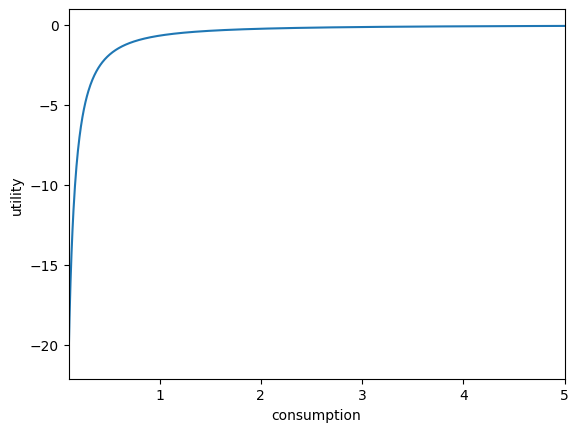
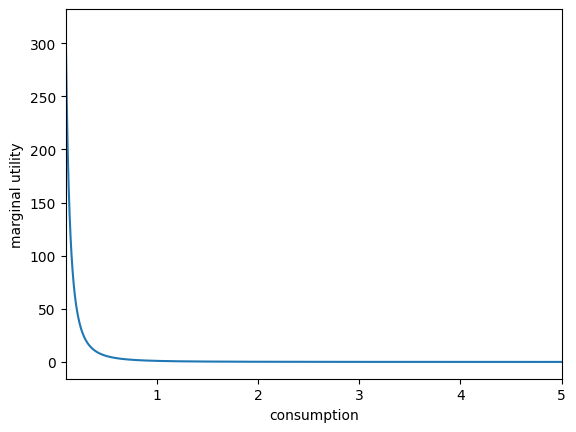
As a notational convention, HARK uses a capital P to denote “prime”, and _inv for “inverse”. HARK.rewards defines several layers of derivative and inverses for CRRA utility:
CRRAutility: utility functionCRRAutilityP: marginal utility functionCRRAutilityPP: marginal marginal utility functionCRRAutilityPPP: marginal marginal marginal utility functionCRRAutilityPPPP: marginal marginal marginal marginal utility functionCRRAutility_inv: inverse utility functionCRRAutilityP_inv: inverse marginal utility functionCRRAutility_invP: marginal inverse utility functionCRRAutilityP_invP: marginal inverse marginal utility function
Utility Function Structure#
The second way to use CRRA utility is to simply import the class UtilityFuncCRRA and instantiate it with a single argument for \(\rho\). This object then represents the utility function and all of its derivatives and inverses. Let’s see an example.
[6]:
U = UtilityFuncCRRA(2.0) # CRRA utility function with rho=2
[7]:
plt.xlabel("consumption")
plt.ylabel("utility")
plot_funcs(U, 0.1, 5.0) # treat it like a function
plt.xlabel("consumption")
plt.ylabel("marginal utility")
plot_funcs(U.derivative, 0.1, 5) # use its derivative method for marginal utility
plt.xlabel("utility")
plt.ylabel("consumption")
plot_funcs(U.inverse, -10.0, -0.1) # use its inverse method
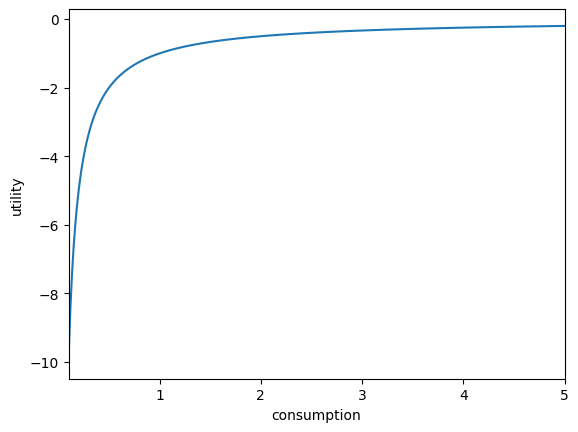
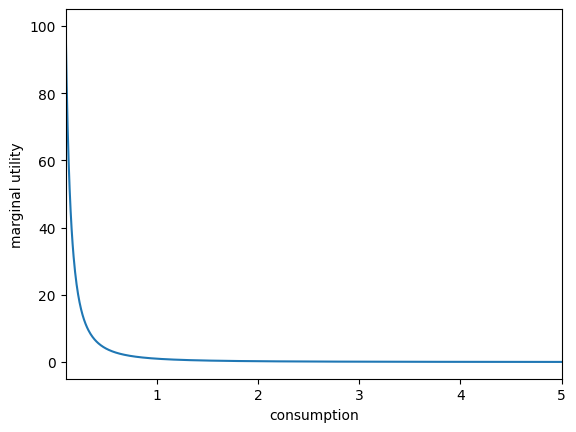
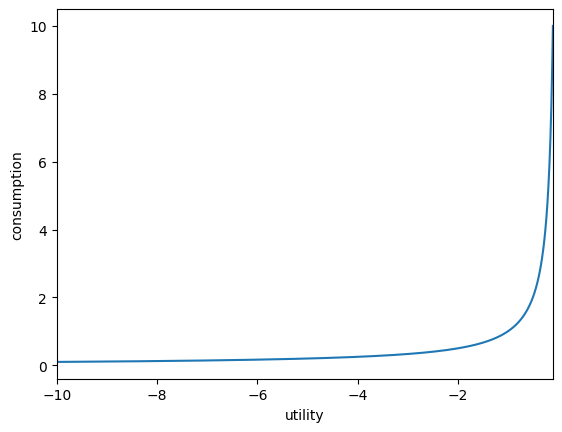
The derivative method accepts a second optional argument of order with a default of 1, indicating the order of the derivative (first to fourth order).
The inverse method also accepts an order argument as an ordered pair (0,0) to (1,1). For a simple mnemonic, order refers to the number of Ps in the function CRRAutility[#1]_inv[#2]. The default is (0,0), which is just the inverse of utility.
Other Utility Functions in HARK.rewards#
Four other utility functions have various levels of support in HARK, but are rarely used:
Stone-Geary: Modified CRRA utility of the form \(U(c) = b \frac{(c+a)^{1-\rho}}{1-\rho}\), with a default of \(b=1\).
Constant Absolute Risk Aversion (CARA): Normalized exponential utility of the form \(U(c) = 1 - \exp(-\alpha c) / \alpha\).
Cobb-Douglas: Cobb-Douglas aggregator for an aribtrary number of goods: \(U(x) = \prod_{j=1}^J x_j^{\zeta_j}\).
Constant Elastisticity of Substitution (CES): CES aggregator characterized by elasticity \(\epsilon\), shares \(\zeta\), scaling factor \(\alpha\) and homogeneity degree \(\eta\): \(U(x) = \alpha \left(\prod_{j=1}^J \zeta_j x_j^\epsilon \right)^{\eta / \epsilon}\).
Each of these utility forms has a utility function class, but the inverse methods are not defined for multiple-input forms.
Representing Distributions#
The HARK.distributions module provides a fairly wide array of representations of distributions for random variables.
Basics of Distributions in HARK#
All distribution classes have some common methods and attributes:
seed: An integer attribute that can be set at instantiation. It is used as the seed for the distribution’s internal random number generator.random_seed(): A method to draw a new random seed for the distribution. This is not recommended for computations that need to be precisely replicated.reset(): A method to reset the distribution’s internal RNG by using its own storedseed.draw(N): A method to generate \(N\) random draws from the distribution.discretize(N, method): A method to generate aDiscreteDistributionbased on this distribution object. The only universally required input is \(N\), the number of nodes in the discretization, but a stringmethodcan be passed as well, along with method-specifickwds.infimum: The greatest lower bound for the support of the distribution; it is always an array, even for univariate distributions.supremum: The least upper bound for the support of the distribution; it is always an array.
Our Workhorse: DiscreteDistribution#
Almost all computation in HARK actually uses discretized approximations of continuous RVs. The default discretization method is equiprobable (which actually has options for non-equiprobable discretizations in some cases), rather than Gaussian methods. This approach is meant to ensure that the mean of the distribution is exactly preserved by the discretization.
The key attributes of a DiscreteDistribution are pmv and atoms. The pmv is the probability mass vector, a np.array that should sum to 1, representing the probability masses for each of the nodes.
The discretized nodes are stored in the atoms attribute as a 2D np.array, even for univariate distributions. The first dimension (axis=0) indexes multiple components of a multivariate distribution, and the second dimension (axis=1) index the nodes.
A DiscreteDistribution that is created from a continuous distribution object using its discretize method should have an attribute called limit with information about how it was generated:
dist: a reference to the continuous distribution itselfmethod: the name of the method that was used to build the approximationN: the number of nodes requestedinfimum: the infimum of the continuous distribution from which it was madesupremum: the supremum of the continuous distribution from which it was made
We included this so that HARK’s solvers can use (particularly) information about the “best” and “worst” things that can happen, even if they don’t appear in the discretization. This is sometimes important for bounding behavior of the model solution.
Say My Name: DiscreteDistributionLabeled#
The default behavior in HARK is for multivariate distributions to simply be indexed by number. E.g. a joint distribution of permanent and transitory income shocks might have \(\psi\) at index 0 and \(\theta\) at index 1. However, we also have an extended class called DiscreteDistributionLabeled that allows more information to be provided.
The additional fields for a Labeled distribution are (all optional):
name: a name or title for the distribution, for describing its purposeattrs: a dictionary of attributes, for arbitrary usevar_names: a list of strings naming each variable in the distributionvar_attrs: a list of dictionaries with attributes for each variable in the distribution
A DiscreteDistributionLabeled can be instantiated in two ways:
Passing a
pmv,atoms, andseedalong with any of the optional arguments, generating a completely new object.Passing a
DiscreteDistributionalong with any optional arguments, effectively “converting” the input distribution.
Example Usage#
We won’t show everything in HARK.distribution here, but this is a sampling (no pun intended) of some key features.
[8]:
import numpy as np
from HARK.distributions import (
Lognormal,
add_discrete_outcome,
add_discrete_outcome_constant_mean,
DiscreteDistributionLabeled,
expected,
)
[9]:
# Make a lognormal distribution and draw twenty numbers from it
F = Lognormal(mu=0.2, sigma=0.7, seed=10202025)
print(F.draw(20))
[0.88164369 1.27060758 0.82340037 0.32759431 1.57918536 1.23739098
1.52478804 2.82758116 1.77216365 0.45260362 1.03188809 0.77631269
4.06323317 0.97823279 2.11448412 2.90854828 0.89516082 2.9296455
0.8560163 0.75149165]
[10]:
# Make a discrete approximation of the lognormal and print information about it
F_approx = F.discretize(N=9)
print(F_approx.pmv) # equiprobable!
print(F_approx.atoms) # univariate, but is a 2D array
print(np.dot(F_approx.atoms, F_approx.pmv)) # mean of discretization
print("Mean of true distribution is " + str(np.exp(F.mu + 0.5 * F.sigma**2)))
[0.11111111 0.11111111 0.11111111 0.11111111 0.11111111 0.11111111
0.11111111 0.11111111 0.11111111]
[[0.38465583 0.61952063 0.80874565 1.0034799 1.2233456 1.49178328
1.85298459 2.4281933 4.231703 ]]
[1.5604902]
Mean of true distribution is 1.5604901958326667
[11]:
# Draw twenty numbers from the discretization
F_approx.draw(20)
[11]:
array([2.4281933 , 0.38465583, 0.80874565, 0.61952063, 4.231703 ,
0.61952063, 0.61952063, 2.4281933 , 1.49178328, 1.2233456 ,
1.49178328, 1.0034799 , 2.4281933 , 1.85298459, 1.49178328,
2.4281933 , 1.0034799 , 1.0034799 , 0.80874565, 0.61952063])
Notice that when drawing from the true distribution F, we got values from its entire support (any positive real), but when drawing from the 9 point equiprobable discretization, we can only get 9 different values.
[12]:
# Add a point mass at zero
G = add_discrete_outcome(F_approx, x=0.0, p=0.1)
print(G.pmv) # other probabilities proportionally scaled down
print(G.atoms)
print(np.dot(G.atoms, G.pmv))
[0.1 0.1 0.1 0.1 0.1 0.1 0.1 0.1 0.1 0.1]
[[0. 0.38465583 0.61952063 0.80874565 1.0034799 1.2233456
1.49178328 1.85298459 2.4281933 4.231703 ]]
[1.40444118]
[13]:
# Add a point mass at zero, but preserve the original mean
H = add_discrete_outcome_constant_mean(F_approx, x=0.0, p=0.1)
print(H.pmv)
print(H.atoms)
print(np.dot(H.atoms, H.pmv))
[0.1 0.1 0.1 0.1 0.1 0.1 0.1 0.1 0.1 0.1]
[[0. 0.42739536 0.68835626 0.89860627 1.11497766 1.35927289
1.65753698 2.05887176 2.69799255 4.70189222]]
[1.5604902]
[14]:
# Make a labeled version of that distribution
H_labeled = DiscreteDistributionLabeled.from_unlabeled(
H, name="permanent income shocks", var_names=["PermShk"]
)
[15]:
# Calculate the expectation of a function of our random variable
temp_func = lambda x, y: x["PermShk"] ** 2 + y
expected_value = expected(temp_func, H_labeled, args=(3.0,))
print(expected_value)
7.092812838769875
The expected utility is useful for writing shorter code within our solvers. It can be used with both ordinary DiscreteDistributions and with Labeled ones. The function passed to expected as its first argument should always take a distribution as its first argument, and index by number or name. Additional arguments are provided in order as args.
Estimation and Optimization#
HARK doesn’t provide many tools for estimating the parameters of particular models– our take is that the details of each particular application are too bespoke to provide a meaningful interface for estimation. We do have a HARK.estimation module, but it is mostly a remapping of functions from scipy.optimize.
In particular, the functions minimize_nelder_mead and minimize_powell remap scipy.optimize.fmin and scipy.optimize.fmin_powell, with a few additional options. In particular, the former function permits an optional argument of which_vars as a Boolean array with length equal to the number of arguments of the function to be minimized; it indicates which dimensions should actually be optimized.
As usual for scipy.optimize functions, the minimand should accept a single input vector. That is, if there are 5 arguments to the function to be minimized, they should be passed as a single np.array.
HARK does provide one hand-programmed optimizer: a parallelized Nelder-Mead minimizer, adapted from Lee and Wiswall. This uses “embarrassingly parallel” techniques from joblib, literally writing to and reading from disk as it spawns and deletes new Python processes. Because of this significant overhead, it should only be used for functions that are relatively “expensive” to evaluate– a few seconds, at least.
See the full documentation for parallelNelderMead for all of the options, but the key inputs are:
obj_func: The function to be optimized, with the same format as usual.guess: Starting point for the optimization, around which a simplex will be built.perturb: A vector of perturbations in each argument, used for building the simplex. Ifperturb[j]is0, that dimension is excluded from the optimization. If noperturbis provided, the default is to optimize all dimensions with an initial simplex of 10% of theguess.P: The degree of parallelization– how many nodes of the simplex to attempt to update on each iteration. Defaults to 1, which is standard Nelder-Mead.maxthreads: The largest number of Python threads to run simultaneously. This can be no greater or less thanP, which is relevant when evaluating the initial simplex or executing a shrink step.name: A filename for optionally storing progress of the search; must be used in conjuction with next two arguments. Useful for very long optimizations that might be interupted by computer downtime.resume: Whether the optimization should resume from prior saved progress (in filename) or start from scratch.savefreq: Frequency (in number of iterations) of writing progress to disk, defaulting to 1 (write after every iteration).
Parallelizing Operations#
HARK has a basic tool for parallelizing operations across AgentType instances. If you have a population of agents that has ex ante heterogeneity– they differ in their parameters, or possibly even in their model, their microeconomic problems can be solved independently and simultaneously. If there is no macroeconomic interaction among AgentType instances, then their models can be simulated independently as well.
The relevant function is HARK.parallel.multi_thread_commands, which takes three arguments:
agent_list: a list ofAgentTypeinstances for which parallel work should be performedcommand_list: a list of strings naming methods to be runnum_jobs: optionally, a maximum number of Python threads to spawn
The function returns no output; agent_list itself is changed by running multi_thread_commands.
There are two caveats when using multi_thread_commands:
Each element of
command_listmust include()at the end, e.g.solve(). This will be changed in the future.AgentTypeinstances can be large and thus take considerable time topicklewhen writing to disk (and then reading from disk). This is particularly the case when model is solved and simulated by the multithreaded process, as bothsolutionandhistorycan be large. If you find that this is a problem, try to find ways to “pre-process” the output at theAgentTypeinstance level, before it exits the spawned thread, and delete the attributes that you don’t strictly “need”.
We have also included a trivial multi_thread_commands_fake function, which replicates the interface of multi_thread_commands but does not use the Parallel package for spawning processes. Instead, it simply loops over the elements of agent_list and executes the methods for each one. This function is included to have a quick way to “turn off” multi-threading in your code.
Life-Cycle Parameter Calibrations#
The default parameters for each AgentType subclass are just meant to be workable examples, not represent anything “realistic”. Some of the default parameters are reasonable or vaguely in the ballpark of values you might get from empirical measurements (e.g. a CRRA of 2 or risk free interest factor of 1.02), but this is mostly coincidence or us being too lazy to make up unreasonable values.
The HARK.Calibration module includes some off-the-shelf calibrations of life-cycle processes, estimated by people who are better with data than we are. It also has some functions for making particular parametric distributions for income processes.
Income Processes#
[16]:
from HARK.Calibration.Income.IncomeTools import Cagetti_income, parse_income_spec
See the documentation for full details, but the main tool for handling life-cycle income specifications is parse_income_spec. This function takes a large number of inputs, but conveniently we have provided some dictionaries for quick use. This function produces a dictionary with a variety of income process parameters, which can be passed to an AgentType subclass to produce a realistically calibrated instance of that class (with HARK’s default income process, or something similar to
it).
[17]:
# Make an income process dictionary for high-school-educated men based on Cagetti (2003)
my_income_params = parse_income_spec(age_min=22, age_max=110, **Cagetti_income["HS"])
print(my_income_params.keys())
print(
len(my_income_params["PermShkStd"])
) # number of non-terminal periods in the model
dict_keys(['PermGroFacAgg', 'PermGroFac', 'PermShkStd', 'TranShkStd', 'P0', 'pLogInitMean', 'T_retire'])
88
Mortality Processes#
HARK can also construct life-cycle mortality probabilities based on Social Security Administration actuarial tables. This tool is currently buried quite deep in HARK, at HARK.Calibration.life_tables.us_ssa.SSATools.parse_ssa_life_table, but we will expose it more conveniently in the near future.
[18]:
from HARK.Calibration.life_tables.us_ssa.SSATools import parse_ssa_life_table
[19]:
# Make survival probabilities for men born in 1980
my_LivPrb = parse_ssa_life_table(age_min=22, age_max=110, female=False, cohort=1980)
print(len(my_LivPrb))
print(my_LivPrb[:10]) # first 10 survival probabilities, from start of model life
88
[0.998541, 0.998511, 0.998545, 0.99852, 0.998489, 0.998549, 0.998583, 0.998606, 0.998592, 0.998535]
Unlike parse_income_spec, this function returns only survival probabilities, which are used as LivPrb in most HARK models.
Using Parsed Parameters in a Model#
Let’s show a simple example of how to use the parameters we imported in an AgentType instance.
[20]:
# Put the parsed parameters together into an IndShockConsumerType
T = 110 - 22 # number of non-terminal periods
CalibratedType = IndShockConsumerType(
LivPrb=my_LivPrb,
T_cycle=T,
Rfree=T * [1.02],
**my_income_params,
)
[21]:
# Solve the life-cycle problem for this agent
CalibratedType.solve()
[22]:
# Plot the consumption function at all ages
CalibratedType.unpack("cFunc")
plt.xlabel(r"Normalized market resources $m_t$")
plt.ylabel(r"Normalized consumption $c_t$")
plt.ylim(0.0, 5.0)
plot_funcs(CalibratedType.cFunc, 0.0, 10.0)
